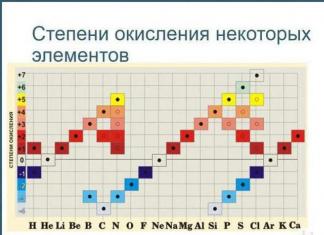Oxides- these are complex inorganic compounds consisting of two elements, one of which is oxygen (in oxidation state -2).
For example, Na 2 O, B 2 O 3, Cl 2 O 7 are classified as oxides. All of these substances contain oxygen and one more element. The substances Na 2 O 2 , H 2 SO 4 , and HCl are not oxides: in the first, the oxidation state of oxygen is -1, in the second there are not two, but three elements, and the third does not contain oxygen at all.
If you don't understand the meaning of the term oxidation number, that's okay. First, you can refer to the corresponding article on this site. Secondly, even without understanding this term, you can continue reading. You can temporarily forget about mentioning the oxidation state.
Oxides of almost all currently known elements have been obtained, except for some noble gases and “exotic” transuranium elements. Moreover, many elements form several oxides (for nitrogen, for example, six are known).
Nomenclature of oxides
We must learn to name oxides. It's very simple.Example 1. Name the following compounds: Li 2 O, Al 2 O 3, N 2 O 5, N 2 O 3.
Li 2 O - lithium oxide,
Al 2 O 3 - aluminum oxide,
N 2 O 5 - nitric oxide (V),
N 2 O 3 - nitric oxide (III).
Please note an important point: if the valence of an element is constant, we do NOT mention it in the name of the oxide. If the valence changes, be sure to indicate it in parentheses! Lithium and aluminum have constant valence, nitrogen has a variable valence; It is for this reason that the names of nitrogen oxides are supplemented with Roman numerals symbolizing valence.
Exercise 1. Name the oxides: Na 2 O, P 2 O 3, BaO, V 2 O 5, Fe 2 O 3, GeO 2, Rb 2 O. Do not forget that there are elements with both constant and variable valency.
Another important point: it is more correct to call the substance F 2 O not “fluorine oxide”, but “oxygen fluoride”!
Physical properties of oxides
Physical properties very diverse. This is due, in particular, to the fact that different types of chemical bond. Melting and boiling points vary widely. At normal conditions oxides can be in the solid state (CaO, Fe 2 O 3, SiO 2, B 2 O 3), liquid state(N 2 O 3, H 2 O), in the form of gases (N 2 O, SO 2, NO, CO).
Various colors: MgO and Na 2 O are white, CuO is black, N 2 O 3 is blue, CrO 3 is red, etc.
Melts of oxides with ionic type connections are good electricity, covalent oxides generally have low electrical conductivity.
Oxides classification
All oxides existing in nature can be divided into 4 classes: basic, acidic, amphoteric and non-salt-forming. Sometimes the first three classes are combined into the group of salt-forming oxides, but for us this is not important now. Chemical properties oxides from different classes differ very much, so the issue of classification is very important for further study of this topic!
Let's start with non-salt-forming oxides. They need to be remembered: NO, SiO, CO, N 2 O. Just learn these four formulas!
To move forward we must remember that in nature there are two types simple substances- metals and nonmetals (sometimes another group of semimetals or metalloids is distinguished). If you have a clear understanding of which elements are metals, continue reading this article. If you have the slightest doubt, refer to the material "Metals and non-metals" on that website.
So, let me tell you that all amphoteric oxides are metal oxides, but not all metal oxides are amphoteric. I will list the most important of them: BeO, ZnO, Al 2 O 3, Cr 2 O 3, SnO. The list is not complete, but you should definitely remember the listed formulas! In most amphoteric oxides, the metal exhibits an oxidation state of +2 or +3 (but there are exceptions).
In the next part of the article we will continue to talk about classification; Let's discuss acidic and basic oxides.
Oxides are called complex substances whose molecules include oxygen atoms in oxidation state - 2 and some other element.
can be obtained through the direct interaction of oxygen with another element, or indirectly (for example, during the decomposition of salts, bases, acids). Under normal conditions, oxides occur in solid, liquid and gaseous state, this type of connection is very common in nature. Oxides are contained in Earth's crust. Rust, sand, water, carbon dioxide are oxides.
They are either salt-forming or non-salt-forming.
Salt-forming oxides- these are oxides that, as a result, chemical reactions form salts. These are oxides of metals and non-metals, which, when interacting with water, form the corresponding acids, and when interacting with bases, the corresponding acidic and normal salts. For example, copper oxide (CuO) is a salt-forming oxide because, for example, when it interacts with hydrochloric acid(HCl) salt is formed:
CuO + 2HCl → CuCl 2 + H 2 O.
As a result of chemical reactions, other salts can be obtained:
CuO + SO 3 → CuSO 4.
Non-salt-forming oxides These are oxides that do not form salts. Examples include CO, N 2 O, NO.
Salt-forming oxides, in turn, are of 3 types: basic (from the word «
base »
), acidic and amphoteric.
Basic oxides These metal oxides are called those that correspond to hydroxides belonging to the class of bases. Basic oxides include, for example, Na 2 O, K 2 O, MgO, CaO, etc.
 Chemical properties of basic oxides
Chemical properties of basic oxides
1. Water-soluble basic oxides react with water to form bases:
Na 2 O + H 2 O → 2NaOH.
2. React with acid oxides, forming the corresponding salts
Na 2 O + SO 3 → Na 2 SO 4.
3. React with acids to form salt and water:
CuO + H 2 SO 4 → CuSO 4 + H 2 O.
4. React with amphoteric oxides:
Li 2 O + Al 2 O 3 → 2LiAlO 2.
If the composition of the oxides contains a non-metal or a metal exhibiting the highest valence (usually from IV to VII) as the second element, then such oxides will be acidic. Acidic oxides (acid anhydrides) are those oxides that correspond to hydroxides belonging to the class of acids. These are, for example, CO 2, SO 3, P 2 O 5, N 2 O 3, Cl 2 O 5, Mn 2 O 7, etc. Acidic oxides dissolve in water and alkalis, forming salt and water.
Chemical properties of acid oxides
1. React with water to form an acid:
SO 3 + H 2 O → H 2 SO 4.
But not all acidic oxides react directly with water (SiO 2, etc.).
2. React with based oxides to form a salt:
CO 2 + CaO → CaCO 3
3. React with alkalis, forming salt and water:
CO 2 + Ba(OH) 2 → BaCO 3 + H 2 O.
Part amphoteric oxide includes an element that has amphoteric properties. Amphotericity refers to the ability of compounds to exhibit acidic and basic properties depending on conditions. For example, zinc oxide ZnO can be either a base or an acid (Zn(OH) 2 and H 2 ZnO 2). Amphotericity is expressed in the fact that, depending on the conditions, amphoteric oxides exhibit either basic or acidic properties.
Chemical properties of amphoteric oxides
1. React with acids to form salt and water:
ZnO + 2HCl → ZnCl 2 + H 2 O.
2. React with solid alkalis (during fusion), forming as a result of the reaction salt - sodium zincate and water:
ZnO + 2NaOH → Na 2 ZnO 2 + H 2 O.
When zinc oxide interacts with an alkali solution (the same NaOH), another reaction occurs:
ZnO + 2 NaOH + H 2 O => Na 2.
Coordination number is a characteristic that determines the number of nearby particles: atoms or ions in a molecule or crystal. For each amphoteric metal characteristically its own coordination number. For Be and Zn it is 4; For and Al it is 4 or 6; For and Cr it is 6 or (very rarely) 4;
Amphoteric oxides are usually insoluble in water and do not react with it.
Still have questions? Want to know more about oxides?
To get help from a tutor -.
The first lesson is free!
blog.site, when copying material in full or in part, a link to the original source is required.
DEFINITION
Oxides- Class inorganic compounds, represent connections chemical element with oxygen, in which oxygen exhibits an oxidation state of “-2”.
The exception is oxygen difluoride (OF 2), since the electronegativity of fluorine is higher than that of oxygen and fluorine always exhibits an oxidation state of "-1".
Oxides, depending on the chemical properties they exhibit, are divided into two classes - salt-forming and non-salt-forming oxides. Salt-forming oxides have an internal classification. Among them, acidic, basic and amphoteric oxides are distinguished.
Chemical properties of non-salt-forming oxides
Non-salt-forming oxides exhibit neither acidic, basic, nor amphoteric properties and do not form salts. Non-salt-forming oxides include oxides of nitrogen (I) and (II) (N 2 O, NO), carbon monoxide (II) (CO), silicon oxide (II) SiO, etc.
Despite the fact that non-salt-forming oxides are not capable of forming salts, when carbon monoxide (II) reacts with sodium hydroxide, an organic salt is formed - sodium formate (formic acid salt):
CO + NaOH = HCOONa.
When non-salt-forming oxides interact with oxygen, higher oxides of elements are obtained:
2CO + O 2 = 2CO 2 ;
2NO + O 2 = 2NO 2.
Chemical properties of salt-forming oxides
Among salt-forming oxides, basic, acidic and amphoteric oxides are distinguished, the first of which, when interacting with water, form bases (hydroxides), the second - acids, and the third - exhibit the properties of both acidic and basic oxides.
Basic oxides react with water to form bases:
CaO + 2H 2 O = Ca(OH) 2 + H 2 ;
Li 2 O + H 2 O = 2LiOH.
When basic oxides react with acidic or amphoteric oxides, salts are obtained:
CaO + SiO 2 = CaSiO 3;
CaO + Mn 2 O 7 = Ca(MnO 4) 2;
CaO + Al 2 O 3 = Ca(AlO 2) 2.
Basic oxides react with acids to form salts and water:
CaO + H 2 SO 4 = CaSO 4 + H 2 O;
CuO + H 2 SO 4 = CuSO 4 + H 2 O.
When basic oxides formed by metals in the activity series after aluminum interact with hydrogen, the metals included in the oxide are reduced:
CuO + H 2 = Cu + H 2 O.
Acidic oxides react with water to form acids:
P 2 O 5 + H 2 O = HPO 3 (metaphosphoric acid);
HPO 3 + H 2 O = H 3 PO 4 (orthophosphoric acid);
SO 3 + H 2 O = H 2 SO 4.
Some acidic oxides, for example, silicon (IV) oxide (SiO 2), do not react with water, therefore, the acids corresponding to these oxides are obtained indirectly.
When acidic oxides react with basic or amphoteric oxides, salts are obtained:
P 2 O 5 + 3CaO = Ca 3 (PO 4) 2;
CO 2 + CaO = CaCO 3 ;
P 2 O 5 +Al 2 O 3 = 2AlPO 4.
Acidic oxides react with bases to form salts and water:
P 2 O 5 + 6NaOH = 3Na 3 PO 4 + 3H 2 O;
Ca(OH) 2 + CO 2 = CaCO 3 ↓ + H 2 O.
Amphoteric oxides interact with acidic and basic oxides (see above), as well as with acids and bases:
Al 2 O 3 + 6HCl = 2AlCl 3 + 3H 2 O;
Al 2 O 3 + NaOH + 3H 2 O = 2Na;
ZnO + 2HCl = ZnCl 2 + H 2 O;
ZnO + 2KOH + H 2 O = K 2 4
ZnO + 2KOH = K 2 ZnO 2 .
Physical properties of oxides
Most oxides are solids at room temperature (CuO is a black powder, CaO is white crystalline substance, Cr 2 O 3 – green powder, etc.). Some oxides are liquids (water - hydrogen oxide - colorless liquid, Cl 2 O 7 - colorless liquid) or gases (CO 2 - colorless gas, NO 2 - brown gas). The structure of oxides is also different, most often molecular or ionic.
Obtaining oxides
Almost all oxides can be obtained by the reaction of a specific element with oxygen, for example:
2Cu + O 2 = 2CuO.
The formation of oxides also results from the thermal decomposition of salts, bases and acids:
CaCO 3 = CaO + CO 2;
2Al(OH) 3 = Al 2 O 3 + 3H 2 O;
4HNO 3 = 4NO 2 + O 2 + 2H 2 O.
Other methods for producing oxides include roasting binary compounds, for example, sulfides, oxidation higher oxides to lower ones, reduction of lower oxides to higher ones, interaction of metals with water at high temperature and etc.
Examples of problem solving
EXAMPLE 1
| Exercise | During the electrolysis of 40 mol of water, 620 g of oxygen were released. Determine the oxygen yield. |
| Solution | The yield of the reaction product is determined by the formula: η = m pr / m theor × 100%. The practical mass of oxygen is the mass indicated in the problem statement – 620 g. The theoretical mass of the reaction product is the mass calculated from the reaction equation. Let us write down the equation for the reaction of water decomposition under the influence of electric current: 2H 2 O = 2H 2 + O 2. According to the reaction equation n(H 2 O):n(O 2) = 2:1, therefore n(O 2) = 1/2×n(H 2 O) = 20 mol. Then, the theoretical mass of oxygen will be equal to: |
Today we begin our acquaintance with the most important classes inorganic compounds. Inorganic substances are divided according to their composition, as you already know, into simple and complex.
|
OXIDE |
ACID |
BASE |
SALT |
|
E x O y |
NnA A – acidic residue |
Me(OH)b OH – hydroxyl group |
Me n A b |
Complex inorganic substances are divided into four classes: oxides, acids, bases, salts. We start with the oxide class.
OXIDES
Oxides
- these are complex substances consisting of two chemical elements, one of which is oxygen, with a valence of 2. Only one chemical element - fluorine, when combined with oxygen, forms not an oxide, but oxygen fluoride OF 2.
They are simply called “oxide + name of the element” (see table). If the valency of a chemical element is variable, it is indicated by a Roman numeral enclosed in parentheses after the name of the chemical element.
|
Formula |
Name |
Formula |
Name |
|
carbon(II) monoxide |
Fe2O3 |
iron(III) oxide |
|
|
nitric oxide (II) |
CrO3 |
chromium(VI) oxide |
|
|
Al2O3 |
aluminium oxide |
zinc oxide |
|
|
N2O5 |
nitric oxide (V) |
Mn2O7 |
manganese(VII) oxide |
Oxides classification
All oxides can be divided into two groups: salt-forming (basic, acidic, amphoteric) and non-salt-forming or indifferent.
|
Metal oxides Fur x O y |
Non-metal oxides neMe x O y |
|||
|
Basic |
Acidic |
Amphoteric |
Acidic |
Indifferent |
|
I, II Meh |
V-VII Me |
ZnO,BeO,Al 2 O 3, Fe 2 O 3 , Cr 2 O 3 |
> II neMe |
I, II neMe CO, NO, N2O |
1). Basic oxides are oxides that correspond to bases. The main oxides include oxides metals 1 and 2 groups, as well as metals side subgroups with valency I And II (except ZnO - zinc oxide and BeO – beryllium oxide):

2). Acidic oxides- These are oxides, which correspond to acids. Acid oxides include non-metal oxides (except for non-salt-forming ones - indifferent), as well as metal oxides side subgroups with valency from V before VII (For example, CrO 3 - chromium (VI) oxide, Mn 2 O 7 - manganese (VII) oxide):

3). Amphoteric oxides- These are oxides, which correspond to bases and acids. These include metal oxides main and secondary subgroups with valency III , Sometimes IV , as well as zinc and beryllium (For example, BeO, ZnO, Al 2 O 3, Cr 2 O 3).
4). Non-salt-forming oxides– these are oxides indifferent to acids and bases. These include non-metal oxides with valency I And II (For example, N 2 O, NO, CO).
Conclusion: the nature of the properties of oxides primarily depends on the valence of the element.
For example, chromium oxides:
CrO(II- main);
Cr 2 O 3 (III- amphoteric);
CrO3(VII- acidic).
Oxides classification
(by solubility in water)
|
Acidic oxides |
Basic oxides |
Amphoteric oxides |
|
Soluble in water. Exception – SiO 2 (not soluble in water) |
Only oxides of alkali and alkaline earth metals dissolve in water (these are metals I "A" and II "A" groups, exception Be, Mg) |
They do not interact with water. Insoluble in water |
Complete the tasks:
1. Write it out separately chemical formulas salt-forming acidic and basic oxides.
NaOH, AlCl 3, K 2 O, H 2 SO 4, SO 3, P 2 O 5, HNO 3, CaO, CO.
2. Given substances : CaO, NaOH, CO 2, H 2 SO 3, CaCl 2, FeCl 3, Zn(OH) 2, N 2 O 5, Al 2 O 3, Ca(OH) 2, CO 2, N 2 O, FeO,
SO 3, Na 2 SO 4, ZnO, CaCO 3, Mn 2 O 7, CuO, KOH, CO, Fe(OH) 3
Obtaining oxides
Simulator "Interaction of oxygen with simple substances"
|
1. Combustion of substances (Oxidation with oxygen) |
a) simple substances Training apparatus |
2Mg +O 2 =2MgO |
|
b) complex substances |
2H 2 S+3O 2 =2H 2 O+2SO 2 |
|
|
2. Decomposition of complex substances (use table of acids, see appendices) |
a) salts SALTt= BASIC OXIDE+ACID OXIDE |
CaCO 3 = CaO + CO 2 |
|
b) Insoluble bases Me(OH)bt= Me x O y+ H 2 O |
Cu(OH)2t=CuO+H2O |
|
|
c) oxygen-containing acids NnA=ACID OXIDE + H 2 O |
H 2 SO 3 =H 2 O+SO 2 |
Physical properties of oxides
At room temperature, most oxides are solids (CaO, Fe 2 O 3, etc.), some are liquids (H 2 O, Cl 2 O 7, etc.) and gases (NO, SO 2, etc.).



Chemical properties of oxides
|
CHEMICAL PROPERTIES OF BASIC OXIDES 1. Basic oxide + Acid oxide = Salt (r. compounds) CaO + SO 2 = CaSO 3 2. Basic oxide + Acid = Salt + H 2 O (exchange solution) 3 K 2 O + 2 H 3 PO 4 = 2 K 3 PO 4 + 3 H 2 O 3. Basic oxide + Water = Alkali (compound) Na 2 O + H 2 O = 2 NaOH |
|
CHEMICAL PROPERTIES OF ACID OXIDES 1. Acidic oxide + Water = Acid (p. compounds) With O 2 + H 2 O = H 2 CO 3, SiO 2 – does not react 2. Acid oxide + Base = Salt + H 2 O (exchange r.) P 2 O 5 + 6 KOH = 2 K 3 PO 4 + 3 H 2 O 3. Basic oxide + Acid oxide = Salt (r. compounds) CaO + SO 2 = CaSO 3 4. Less volatile ones displace more volatile ones from their salts CaCO 3 + SiO 2 = CaSiO 3 + CO 2 |
|
CHEMICAL PROPERTIES OF AMPHOTERIC OXIDES They interact with both acids and alkalis. ZnO + 2 HCl = ZnCl 2 + H 2 O ZnO + 2 NaOH + H 2 O = Na 2 [Zn (OH) 4] (in solution) ZnO + 2 NaOH = Na 2 ZnO 2 + H 2 O (when fused) |
Application of oxides
Some oxides are insoluble in water, but many react with water to form compounds:
SO 3 + H 2 O = H 2 SO 4
CaO + H 2 O = Ca( OH) 2
The result is often very necessary and useful compounds. For example, H 2 SO 4 – sulfuric acid, Ca(OH) 2 – slaked lime, etc.
If oxides are insoluble in water, then people skillfully use this property. For example, zinc oxide ZnO is a white substance, therefore it is used to prepare white oil paint (zinc white). Since ZnO is practically insoluble in water, any surface can be painted with zinc white, including those that are exposed to precipitation. Insolubility and non-toxicity allow this oxide to be used in the manufacture of cosmetic creams and powders. Pharmacists make it into an astringent and drying powder for external use.
Titanium (IV) oxide – TiO 2 – has the same valuable properties. It also has a beautiful white color and is used to make titanium white. TiO 2 is insoluble not only in water, but also in acids, so coatings made from this oxide are especially stable. This oxide is added to plastic to give it a white color. It is part of enamels for metal and ceramic dishes.
Chromium (III) oxide - Cr 2 O 3 - very strong dark green crystals, insoluble in water. Cr 2 O 3 is used as a pigment (paint) in the manufacture of decorative green glass and ceramics. The well-known GOI paste (short for the name “State Optical Institute”) is used for grinding and polishing optics, metal products, in jewelry.
Due to the insolubility and strength of chromium (III) oxide, it is also used in printing inks (for example, for coloring banknotes). In general, oxides of many metals are used as pigments for a wide variety of paints, although this is far from their only application.
Tasks for consolidation
1. Write out separately the chemical formulas of salt-forming acidic and basic oxides.
NaOH, AlCl 3, K 2 O, H 2 SO 4, SO 3, P 2 O 5, HNO 3, CaO, CO.
2. Given substances : CaO, NaOH, CO 2, H 2 SO 3, CaCl 2, FeCl 3, Zn(OH) 2, N 2 O 5, Al 2 O 3, Ca(OH) 2, CO 2, N 2 O, FeO, SO 3, Na 2 SO 4, ZnO, CaCO 3, Mn 2 O 7, CuO, KOH, CO, Fe(OH) 3
Select from the list: basic oxides, acidic oxides, indifferent oxides, amphoteric oxides and give them names.
3. Complete the CSR, indicate the type of reaction, name the reaction products
Na 2 O + H 2 O =
N 2 O 5 + H 2 O =
CaO + HNO3 =
NaOH + P2O5 =
K 2 O + CO 2 =
Cu(OH) 2 = ? + ?
4. Carry out transformations according to the scheme:
1) K → K 2 O → KOH → K 2 SO 4
2) S→SO 2 →H 2 SO 3 →Na 2 SO 3
3) P→P 2 O 5 →H 3 PO 4 →K 3 PO 4
Oxides are complex substances consisting of two elements, one of which is oxygen. In the names of oxides, the word oxide is first indicated, then the name of the second element by which it is formed. What features do acid oxides have, and how do they differ from other types of oxides?
Oxides classification
Oxides are divided into salt-forming and non-salt-forming. Already from the name it is clear that non-salt-forming ones do not form salts. There are few such oxides: water H 2 O, oxygen fluoride OF 2 (if it is conventionally considered an oxide), carbon monoxide, or carbon monoxide (II), carbon monoxide CO; nitrogen oxides (I) and (II): N 2 O (dianitrogen oxide, laughing gas) and NO (nitrogen monoxide).
Salt-forming oxides form salts when reacting with acids or alkalis. As hydroxides they correspond to bases, amphoteric bases and oxygen-containing acids. Accordingly, they are called basic oxides (eg CaO), amphoteric oxides (Al 2 O 3) and acid oxides or acid anhydrides (CO 2).

Rice. 1. Types of oxides.
Often students are faced with the question of how to distinguish a basic oxide from an acidic one. First of all, you need to pay attention to the second element next to oxygen. Acidic oxides - contain a non-metal or transition metal(CO 2, SO 3, P 2 O 5) basic oxides - contain metal (Na 2 O, FeO, CuO).
Basic properties of acid oxides
Acidic oxides (anhydrides) are substances that exhibit acidic properties and form oxygen-containing acids. Therefore, acidic oxides correspond to acids. For example, the acidic oxides SO 2 and SO 3 correspond to the acids H 2 SO 3 and H 2 SO 4 .

Rice. 2. Acidic oxides with corresponding acids.
Acidic oxides formed by nonmetals and metals with variable valence in highest degree oxidation (for example, SO 3, Mn 2 O 7), react with basic oxides and alkalis, forming salts:
SO 3 (acid oxide) + CaO (basic oxide) = CaSO 4 (salt);
Typical reactions are the interaction of acidic oxides with bases, resulting in the formation of salt and water:
Mn 2 O 7 (acid oxide) + 2KOH (alkali) = 2KMnO 4 (salt) + H 2 O (water)
All acidic oxides, except silicon dioxide SiO 2 (silicon anhydride, silica), react with water, forming acids:
SO 3 (acid oxide) + H 2 O (water) = H 2 SO 4 (acid)
Acidic oxides are formed by interaction with oxygen of simple and complex substances (S+O 2 =SO 2), or by decomposition as a result of heating of complex substances containing oxygen - acids, insoluble bases, salts (H 2 SiO 3 =SiO 2 +H 2 O).
List of acid oxides:
| Name of acid oxide | Acid Oxide Formula | Properties of acid oxide |
| Sulfur(IV) oxide | SO 2 | colorless toxic gas with a pungent odor |
| Sulfur(VI) oxide | SO 3 | highly volatile, colorless, toxic liquid |
| Carbon monoxide (IV) | CO2 | colorless, odorless gas |
| Silicon(IV) oxide | SiO2 | colorless crystals with strength |
| Phosphorus(V) oxide | P2O5 | white, flammable powder with an unpleasant odor |
| Nitric oxide (V) | N2O5 | substance consisting of colorless volatile crystals |
| Chlorine(VII) oxide | Cl2O7 | colorless oily toxic liquid |
| Manganese(VII) oxide | Mn2O7 | liquid with a metallic luster, which is a strong oxidizing agent. |

Rice. 3. Examples of acid oxides.
What have we learned?
Acidic oxides are salt-forming oxides and are formed with the help of acids. Acidic oxides react with bases and water, and their formation occurs when complex substances are heated and decomposed.
Test on the topic
Evaluation of the report
average rating: 4.5. Total ratings received: 552.


























